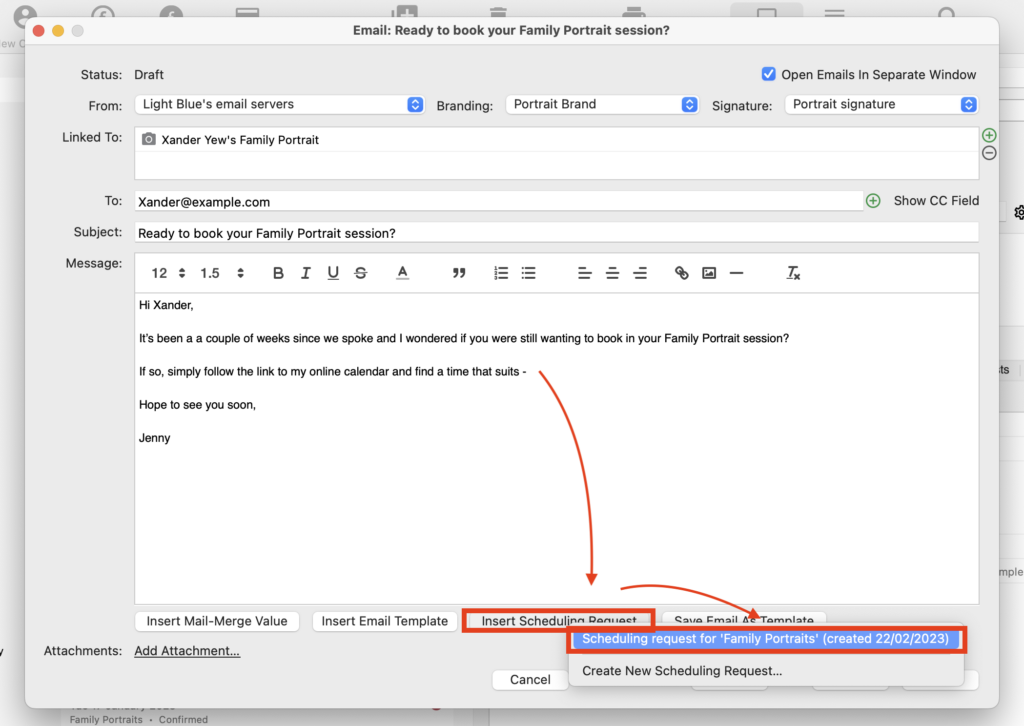Scheduling Calendars: using Scheduling Requests with existing clients
New in Light Blue 2023.1
Scheduling requests allow you to use your scheduling calendars to book meetings or shoots with existing clients. Your clients will love them because the booking form will be pre-filled with the information that you already have, and you will save time because the event that’s created will automatically be linked to the relevant records in Light Blue.
You can insert a scheduling request into an email or text message, and you can automate inviting your clients to book a consultation or viewing session by including them in workflow messages.
When to use scheduling requests
You can use scheduling requests in a number of ways. Here are some of the most popular examples:
- Scheduling an appointment linked to an existing shoot, e.g. a consultation or a viewing session.
- Scheduling a session for an existing shoot, e.g. you’ve used the shoot record to manage the enquiry process without picking a date, you send a scheduling request so that your client can select the date & time and complete the booking process.
- Scheduling a new shoot for an existing contact, e.g. if a returning client wants to make a booking, or you could send scheduling requests to a selection of leads that are already in your database.
- Scheduling a new shoot linked to an existing shoot, e.g. an engagement shoot for a wedding, or querying for a set of shoots (e.g. good spenders from last year) and inviting them to book another shoot.
Your client’s experience
- Your client receives a scheduling request in a message from you, such as an email or text message sent from Light Blue.
- They click on the link and are taken to a web page that looks just like one of your scheduling calendars.
- If you choose to include a booking form in your scheduling request, it’s pre-filled with the information you already have. This makes it really easy for your client to fill in, because they only have to enter new or updated information.
- If your scheduling calendar includes a contract or booking fee, so will this booking process.
Your experience
- You’ll send a scheduling request from a shoot or contact in Light Blue.
- When your client uses a scheduling request to make a booking, the booking is automatically added to your diary, just like a client using any of your scheduling calendars. This prevents anyone else from double-booking that time.
- The event that’s created is automatically linked to the relevant records in Light Blue.
- The booking appears in the Inbox in Light Blue, just like any other online booking.
- If the scheduling request included a booking form, you can double-click on the booking in the Inbox to review the information that your client filled in and import any changes into Light Blue. The booking form doesn’t automatically update records in Light Blue because it’s important that client can’t change anything that already exists in your database without you checking it first.
Things you need to set up before you start using scheduling requests
Scheduling requests use your scheduling calendars, so you need to set up a scheduling calendar for each shoot type or appointment type that you want to ask your client to book.
You can create more than one scheduling calendar for a shoot type or appointment type, so you can offer your clients different options. For example, you could charge one booking fee for new clients that book you via a scheduling calendar embedded in your website, and offer a discounted rate to existing clients by sending them a scheduling request that uses a cheaper booking fee.
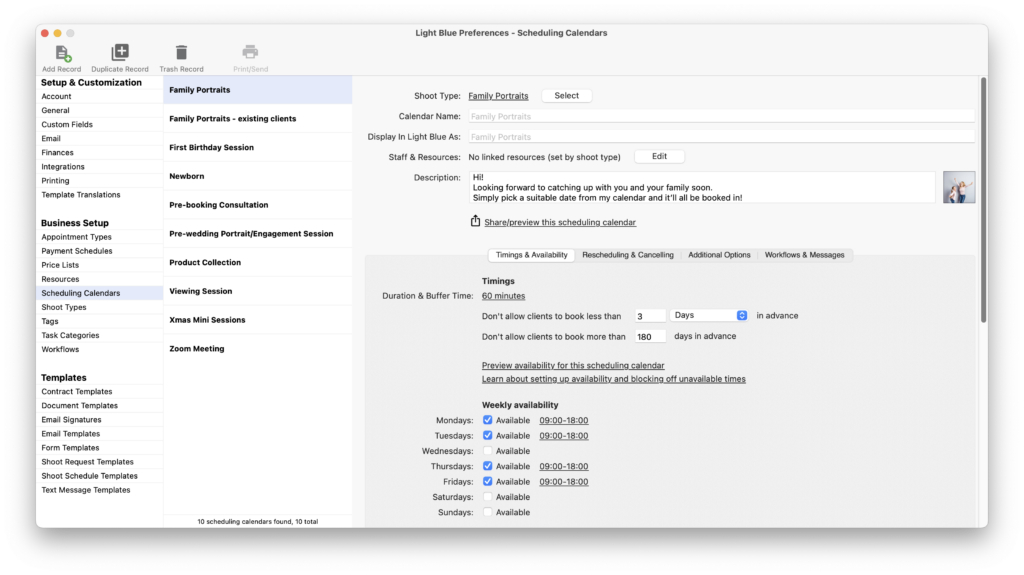
Including a scheduling request in a message
When you’re writing an email or text message in Light Blue, an “Insert Scheduling Request” button appears below the message:
- Click into the message to put the insertion point wherever you want the scheduling request to go.
- Click the “Insert Scheduling Request” button.
- Choose which scheduling calendar you want to use for the request.
- In the options window that appears, you can choose whether to include a booking form. In some cases, you might not include a booking form because you just need your client to choose a date and time.
- If you’re creating a scheduling request to book a shoot and you’re sending it from a shoot, you can choose whether it will create a new shoot or add a session to the shoot you’re sending it from. The “add a session” option is perfect for situations where you’ve been managing an enquiry with a shoot record but the client hasn’t picked a date for their shoot yet.
- You can customise the link text before inserting the scheduling request into your email.
- The link for a scheduling request is unique, so when your client clicks it Light Blue knows which shoot or contact records should be linked to it and what information to show in the booking form.
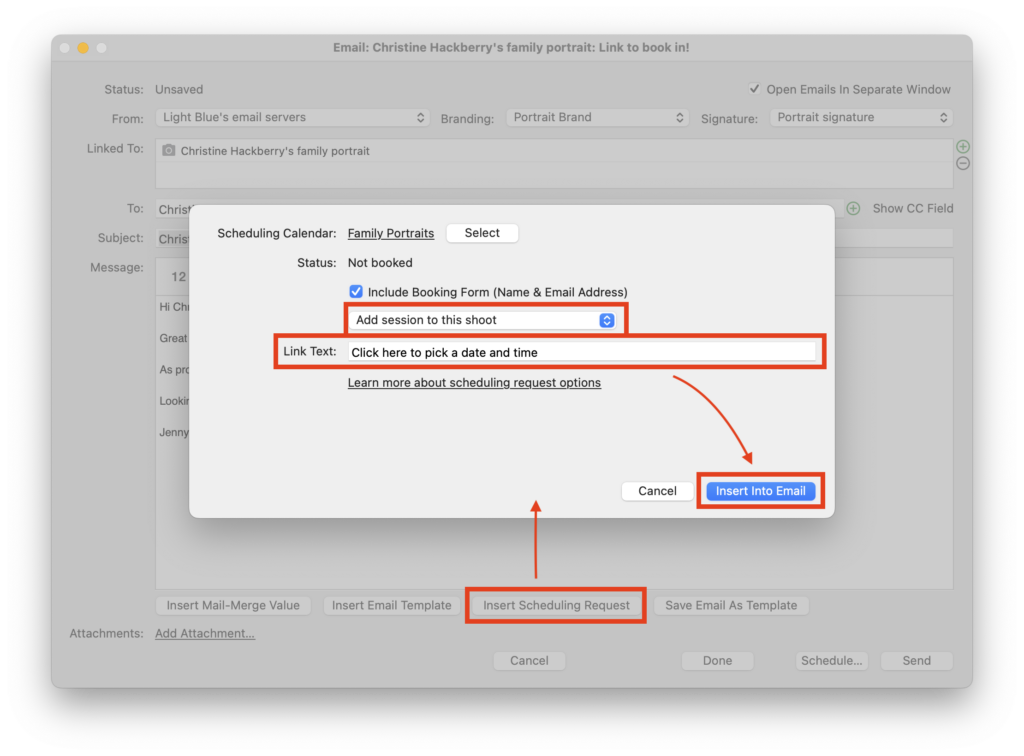
Including a scheduling request in a message template
You can include scheduling requests in your email and text message templates, which makes sending them really quick. When you use a template to create an email or text message, the scheduling request will automatically be linked to the shoot or contact that you send it from:
- In the email template or text message template, click into the message to put the insertion point wherever you want the scheduling request to go.
- Click the “Insert Scheduling Request” button.
- Select the scheduling calendar you want to use, and then choose which options you want to use for the scheduling request. You can choose whether to include the booking form or skip it, and if the scheduling request is for a shoot then you can choose whether to create a new shoot or add a session to the shoot you’re sending it from. You can also customise the link text.
- The mail-merge tag for the scheduling request will be long, but when you use the template it will turn into a clickable link.
- The scheduling request will automatically be linked to the shoot or contact that you send it from.
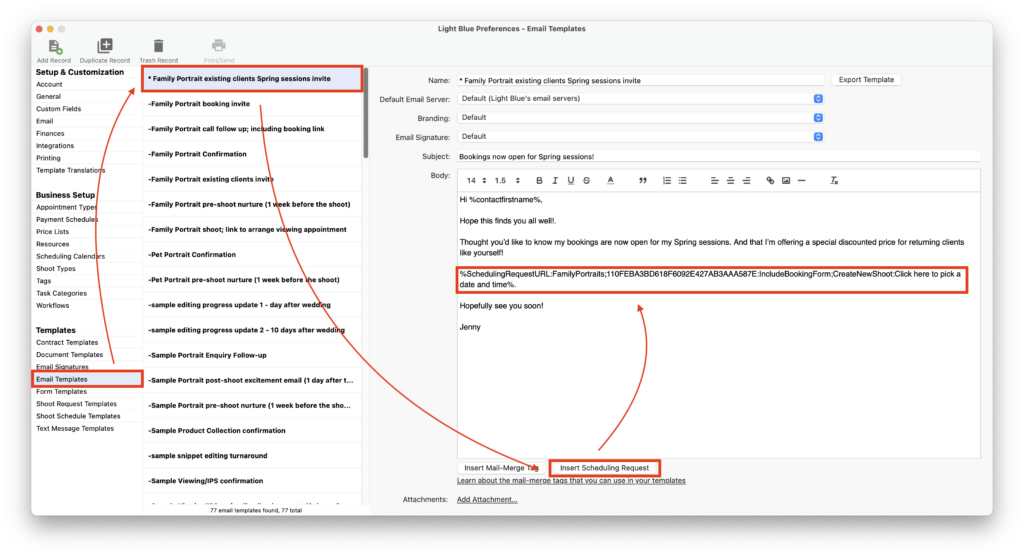
Including scheduling requests in workflows
Workflows can include emails and text messages, so you can include scheduling requests in workflows by adding them to your email and text message templates. This allows you to automate things like:
- Invite your clients to book a viewing session by sending them a scheduling request shortly after their shoot.
- Include a link to book a shoot in the automated messages that are part an enquiry workflow.
When you include scheduling requests in emails or text messages that are part of a workflow, the scheduling requests will automatically be linked to the shoot or contact that you send it from.
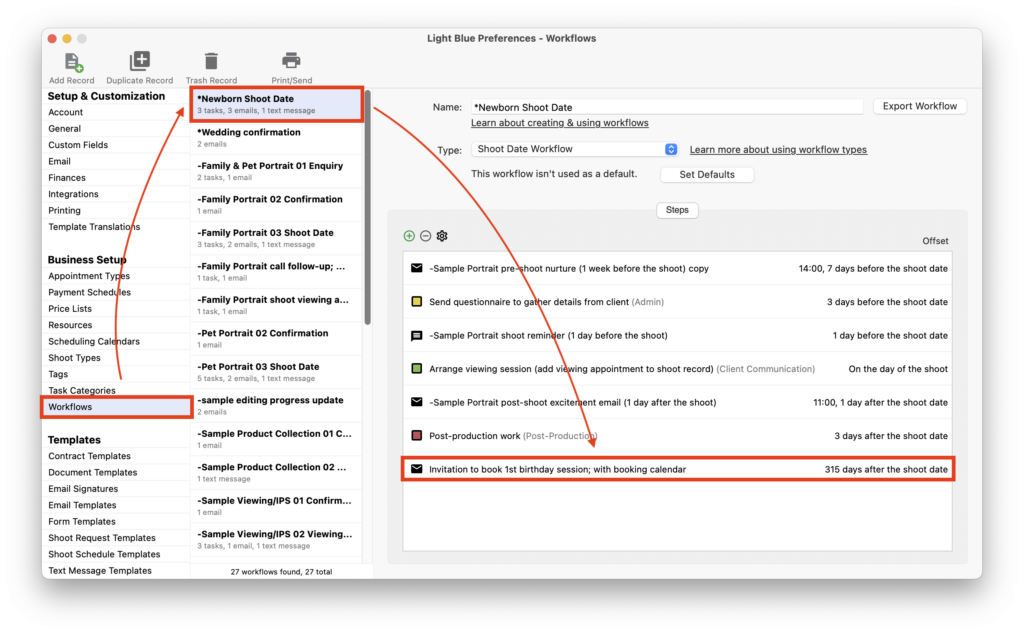
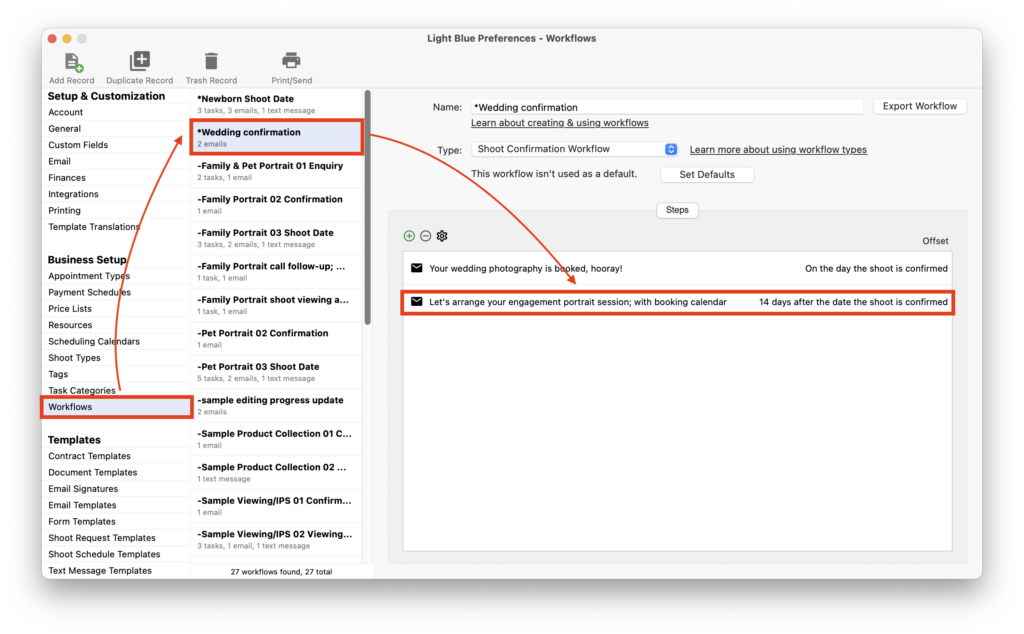
How scheduling requests appear in the Activity panel
In most cases, you’ll be creating scheduling requests by inserting them into a message, using a message template that contains one, or applying a workflow.
When you create a scheduling request, it appears in the Activity panel of the shoot or contact you send it from and you can see whether it’s been used to make a booking. You can double-click on a scheduling request to see its details, and if it hasn’t already been completed then you can use the buttons in there to open it, copy it to your clipboard to paste into another app, or create a message that contains it.
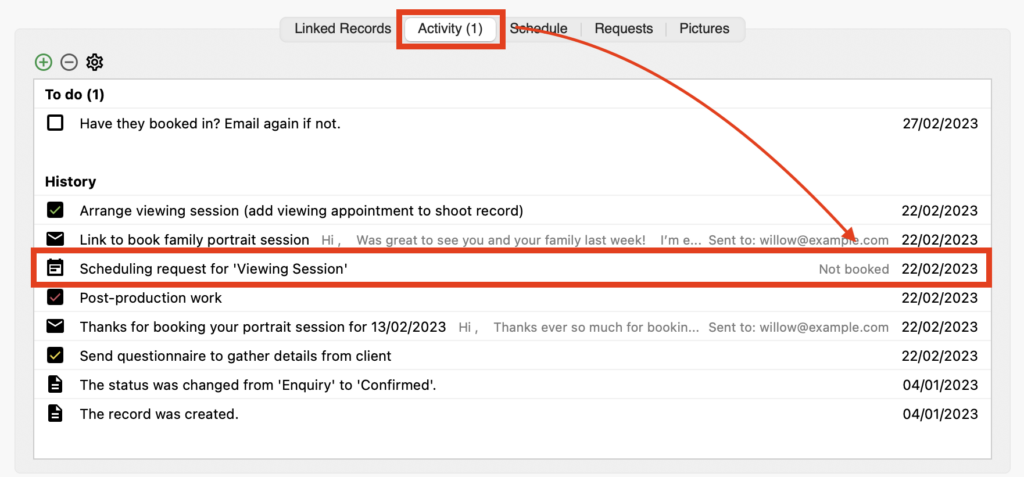
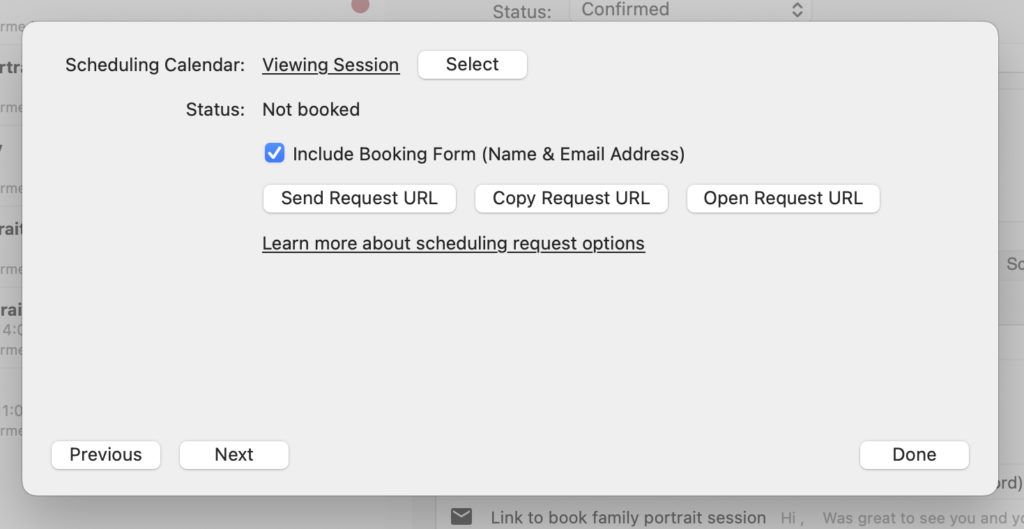
Reusing an existing scheduling request
You can reuse an incomplete scheduling request when you’re writing an email or text message. For example, you could insert a new scheduling request into an email and then include it in a follow-up text message.
If you click the “Insert Scheduling Request” button in an email or text message, any incomplete requests for that shoot or contact will be listed in a popup menu, along with a “Create New Scheduling Request” option.
